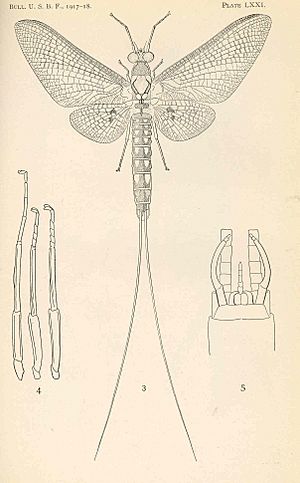Hexagenia bilineata facts for kids
Quick facts for kids Hexagenia bilineata |
|
|---|---|
 |
|
| Scientific classification | |
| Kingdom: | |
| Phylum: | |
| Class: | |
| Order: | |
| Family: |
Ephemeridae
|
| Genus: |
Hexagenia
|
| Species: |
H. bilineata
|
| Binomial name | |
| Hexagenia bilineata (Say, 1824)
|
|
| Synonyms | |
|
|
Hexagenia bilineata is a type of mayfly that belongs to the Ephemeridae family. It lives in North America, especially in the Upper Mississippi Valley. Sometimes, so many of these adult mayflies appear at once that they can be a bit of a bother! The young mayflies, called larvae, live in water and dig into the mud. The adult insects, however, only live for a very short time.
Contents
What Does Hexagenia bilineata Look Like?
When these mayflies are ready to become adults, the young nymphs (larvae) swim up to the water's surface at night. Their skin then splits open. A winged form, called a subimago, quickly breaks free. This usually takes less than a minute. These subimagos then fly to nearby trees to rest. They are a dull gray color. They have short, rough legs and bristly tails called cerci. Their wings are cloudy and grayish.
About eight to eighteen hours later, these subimagos shed their skin again. This time, they become full-grown adults, also known as imagos. The adults look much more delicate than the subimagos. Their wings are clear and see-through. Their legs are longer and thinner. Their tails (cerci) do not have bristles. Their eyes are bigger, and their bodies have patterns of brown and cream colors. Female mayflies are much larger than the males.
Where Do These Mayflies Live?
Hexagenia bilineata is found in the Upper Mississippi Valley. The adult mayflies appear in the summer. You can find them near still or slow-moving water. The young nymphs live by digging into the mud and silt. They prefer shallow lakes and slow-moving streams and rivers. This type of mayfly is usually more common than its close relative, the Hexagenia limbata. However, H. limbata becomes more common north of Keokuk, Iowa. For example, when a lock near Keokuk was emptied in July 1958, many H. bilineata nymphs were found in the mud.
The Life Cycle of Hexagenia bilineata
Around sunset, male adult mayflies gather together in large groups called swarms. They often gather behind buildings or trees. If there is no wind, they might swarm all around these structures. Each male stays in a fixed spot, facing into the wind. They are usually about 30 centimeters (1 foot) from each other. They use their tails (cerci) to help them stay steady. Unlike some other mayflies, they do not bob up and down.
If a female mayfly flies into a swarm, the males will chase her. They will then mate while flying in the air. After mating, the male returns to the swarm. All the males in the swarm will die before morning. The female then lays two groups of eggs into the water. Each group contains thousands of tiny eggs. The eggs sink to the bottom and stick to the mud. The female mayfly dies soon after laying her eggs.
Each egg hatches a few weeks later. The tiny new nymph digs a U-shaped tunnel in the mud. It creates a water current through its burrow. This current brings the oxygen it needs to breathe. It also brings tiny bits of dead plants and animals (detritus) for the nymph to eat. The nymph stays in this burrow until it is ready to emerge as an adult the following year.
This mayfly might have a shorter life cycle than other mayflies in its group. In a lab, when kept warm, they can grow from egg to adult in just thirteen weeks. However, in places like the Keokuk area, they usually have only one generation per year. In Kentucky Lake, some adults emerge after 14 months, while others take 22 months.
When Mayflies Cause a Buzz
Sometimes, huge numbers of Hexagenia bilineata adults emerge all at once. On July 14, 1958, a newspaper reported a big event. The evening before, so many mayflies appeared on the Dubuque Bridge in Dubuque, Iowa. They covered the bridge for 40 minutes! Road crews had to use scraper-trucks to clear them away.
The insects would rest on trees near the river. Sometimes, so many would land that tree branches would break. Houses could get covered in them. It could also be hard to see while driving. Many mayflies even traveled hundreds of miles on towboats pulling barges on the river.
On the evening of July 23, 2014, near La Crosse, Wisconsin, so many mayflies were flying that they showed up on weather radar. The huge swarm looked like a rainstorm! These insects are attracted to lights. Their bodies can pile up in yards, on roads, and on bridges. There was even a car accident reported in nearby Trenton. It was thought to be caused by the slippery conditions from the squashed mayflies on the road.

